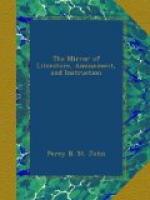Kirkstall Abbey is situated a short distance from Leeds, in the West Riding of Yorkshire. Its situation is one of the most picturesque that the children of romance can wish for, being in a beautiful vale, watered by the river Aire. It was of the Cistercian order, founded by Henry de Lacy in 1157, and valued at the dissolution at 329l. 2s. 11d. Its rents are now worth 10,253l. 6s. 8d. The gateway has been walled up, and converted into a farm-house. The abbot’s palace was on the south; the roof of the aisle is entirely gone; places for six altars, three on each side the high altar, appear by distinct chapels, but to what saints dedicated is not easy, at this time, to discover. The length of the church, from east to west, was 224 feet; the transept, from north to south, 118 feet. The tower, built in the time of Henry VIII., remained entire till January 27, 1779, when three sides of it were blown down, and only the fourth remains. Part of an arched chamber, leading to the cemetery, and part of the dormitory, still remain. On the ceiling of a room in the gatehouse is inscribed,
Mille et Quingentos postquam compleverit
Orbis
Tuq: et ter demos per sua signi Deus
Prima sauluteferi post cunabula Christi,
Cui datur omnium Honor, Gloria, Laus,
et Amor.
The principal window is particularly admired as a rich specimen of Gothic beauty, and a tourist, in 1818, says, “bids defiance to time and tempest;” but in our engraving, which is of very recent date, the details of the window will be sought for in vain. “Shrubs and trees,” observes the same writer, “have found a footing in the crevices, and branches from the walls shook in undulating monotony, and with a gloomy and spiritual murmur, that spoke to the ear of time and events gone by, and lost in oblivion and dilapidation. At the end, immediately beneath the colossal window, grows an alder of considerable luxuriance, which, added to the situation of every other object, brought Mr. Southey’s pathetic ballad of ‘Mary the Maid of the Inn,’ so forcibly before my imagination,[5] that I involuntarily turned my eye to search for the grave, where the murderers concealed their victim.” He likewise tells us of “the former garden of the monastery, still cultivated, and exhibiting a fruitful appearance;” cells and cavities covered with underwood; and his ascent to a gallery by a winding turret stair, whence, says he, “the monks of Kirkstall feasted their eyes with all that was charming in nature. It is said,” adds he, “that a subterraneous passage existed from hence to Eshelt Hall, a distance of some miles, and that the entrance is yet traced.”
[5] We ourselves remember
the thrilling effect of our first reading
this
ballad; especially while clambering over the ruins
of
Brambletye
House. Indeed, the incident of the ballad is of
the
most
sinking character, and it works on the stage with truly
melo-dramatic




